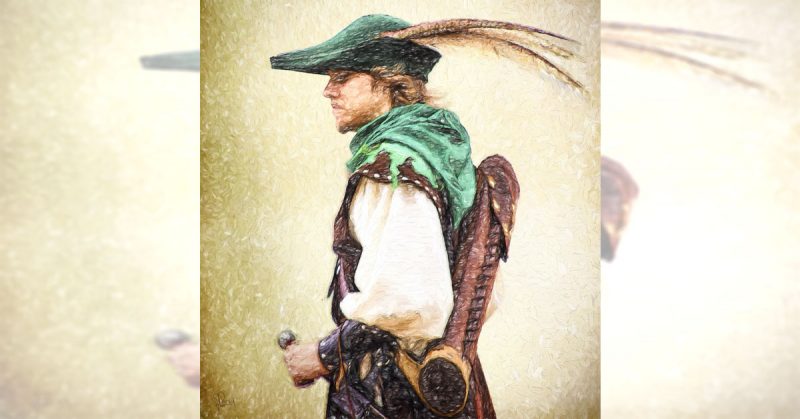On 16 March 1322 a rebellion against King Edward II of England was crushed at the Battle Boroughbridge. Many rebel leaders, including the Earl of Lancaster, were executed. Roger Mortimer, imprisoned following the revolt, would escape from the Tower of London and return to England five years later to help Queen Isabella overthrow her husband.
In the intervening years, many of the rebels lived on the run. Using violent crime both to make a living and to target the men they blamed for their downfall, they contributed to England’s growing lawlessness under Edward II. Some would return to positions of respectability under Mortimer and Isabella, while others would continue as outlaws for many years. Hiding out in the forests of England, and in particular the vast swathes of Sherwood, their activities are among the roots of the Robin Hood legends.
Is one of these criminals the real man behind the mythical outlaw?
William Trussell and His Followers
Sir William Trussell was among the more respectable men to become an outlaw after Boroughbridge. A former Sheriff of Warwick and Leicester, he had served in English armies and attended Parliament. A political opportunist, he joined the revolt because of connections to Lancaster, and tried to raise troops for the Earl’s cause.
Following the revolt, Trussell evaded capture and went on the run. It seems that fear for his life overcame a political pragmatism that let other former rebels work under Edward II. Together with other failed rebels, he launched a string of criminal raids across Somerset and Dorset throughout the summer of 1322. His gang included Sir John Maltravers, Sir Matthew de Clyveden, John de Kingston and Nicholas Percy.
These criminal careers were short lived. Percy was dead by 1324, while Trussell, Clyveden and Kingston were all rehabilitated as the royal government sought to restore order. Maltravers went into exile, becoming part of Mortimer’s opposition in exile.
John de Roddam
A minor Northumbrian landowner, Roddam joined the Lancastrian revolt out of duty to John de Lilleburn. Orders went out for his arrest in March 1322, but he remained at large with a group of kinsmen, outlaws on the run like Trussell and his men. Roddam was killed several years later by John de Heton, son of a royalist – criminality and politics remained intertwined, and some of these men died on the run.
Robert and Jocelin Deyville the Younger
The Deyvilles were a prominent family in Nottinghamshire and Yorkshire, the heartland of the Robin Hood legends. They had a long history of rebelliousness and criminality. A previous generation of the family had rebelled against Henry III in the 1260s, and Sir Jocelin Deyville, the head of the family, was a knightly ruffian notorious for feuding with his neighbours. He was also important enough to be one of the rebel leaders executed with great fanfare a week after the battle.
Jocelin’s corpse was left swinging in the wind for three years, during which time his younger brother Robert returned to violent crime. Jocelin’s rebel death leant the brothers a romanticised reputation as anti-heroes of the Sherwood region, robbing wealthy travellers and raiding religious houses. The church and its monastic orders were powerful landlords, to whom peasants had to pay tithes for everything from living on their land to grinding grain in their mills, so the attacks had an element of social vengeance.
Robert’s behaviour proved an inspiration to his nephew Jocelin, son of the executed rebel. Pardoned following his involvement in the 1322 revolt, the younger Jocelin initially kept his head down. By 1326 he and John Mowbray – whose family also featured among the Boroughbridge rebels – were raiding villages in Nottinghamshire at the head of a gang over 400 men strong.
John and William Bradburn
John and William Bradburn, from a family of Derbyshire landowners, saw their uncle Sir Henry de Bradburn drawn through the streets of York and hanged following the revolt. Having also participated in the rebellion, they William were pardoned, but did not return to polite society. Instead, they became part of the infamous Coterel gang.
The Bradburns themselves had form for burglary, but as members of this gang they were involved in far more infamous deeds, including murder and the robbing of churches. Led by James Coterel, by 1328 they were a large and disparate group, made up of everyone from dispossessed minor landowners to a university scholar and a petty forger. They became infamous in the north and Midlands during the late 1320s and early 1330s, committing assaults, robberies and murders. It is likely that they were responsible for many of the anonymous attacks by armed gangs that plagued the years between Boroughbridge and Mortimer’s return. It seems that the failed rebellion brought them together, and gave a motive for crime.
Nicholas Coterel
The Coterels were not an important family or a wealthy one. Their place in history comes from their criminal activities. But records of Lancaster’s supporters show that one of them at least played a part in his revolt.
Nicholas Coterel definitely fought for Lancaster. Thousands of men did so, and the names of the lesser ones are not recorded, so it is entirely possible that other members of his family were also rebels.
By 1328, Nicholas was in the gang led by James – possibly one of his brothers. He was involved in some of their most notorious crimes during the period of political turmoil that saw Edward II overthrown, and having set off down a path of criminality he never looked back. Though rehabilitated in the 1330s, he used his office as a royal bailiff to interfere with tax collection and steal from the crown.
Though Nicholas’s activities may not sound romantic now, it is easy to see the roots of the Robin Hood legend in these acts of government-defying criminality. He may not have given to the poor, but he was certainly robbing the rich, and defying authority in the process.
